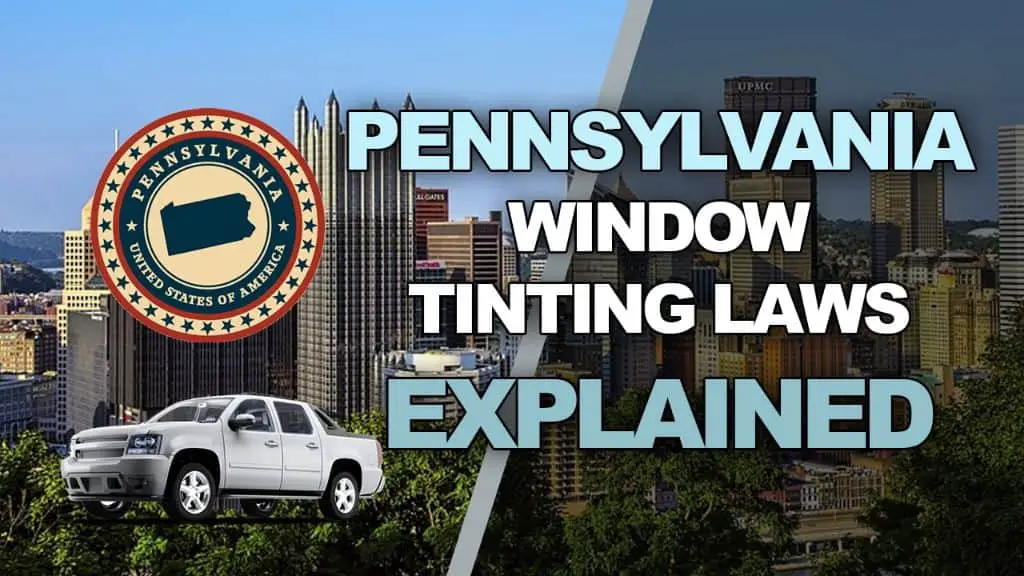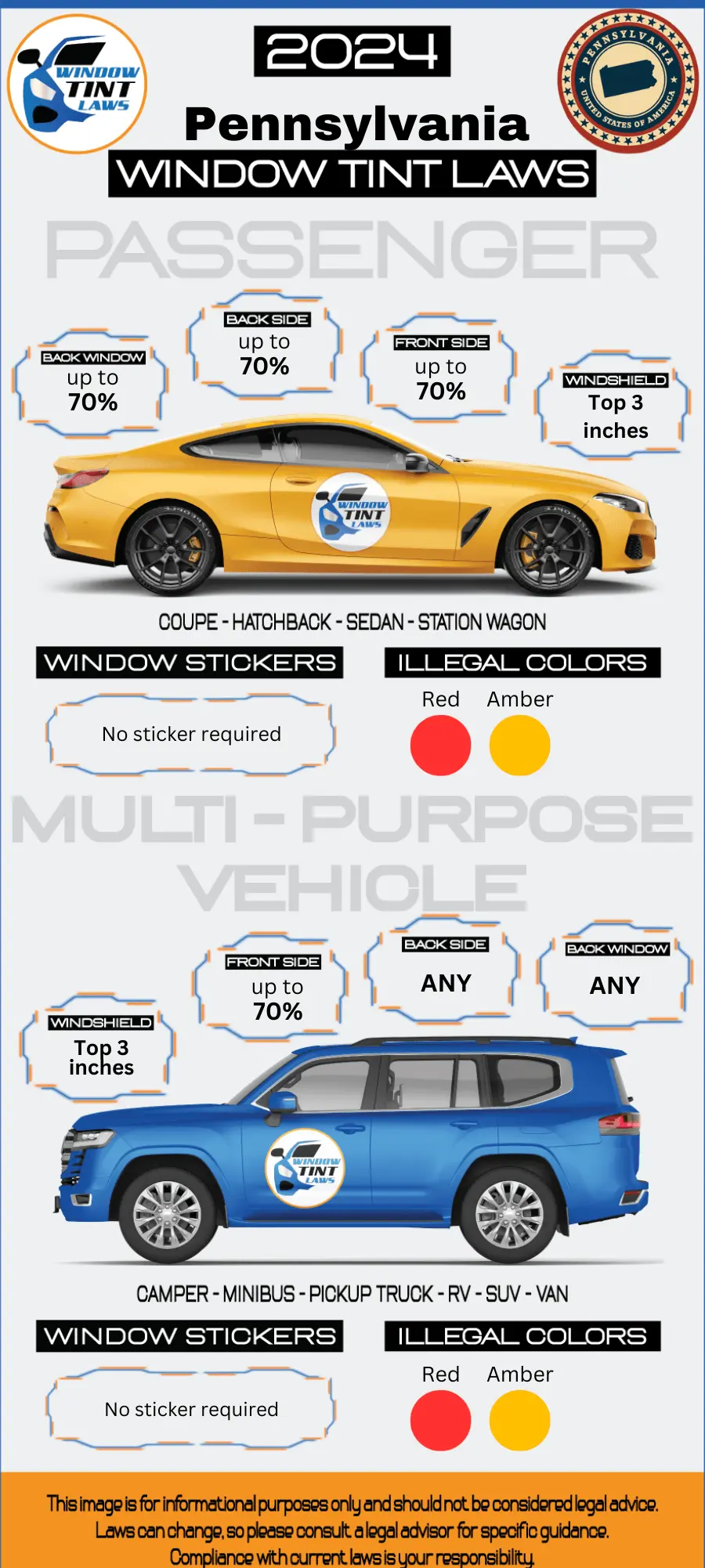

Article Created by Ryan Pietrzak
Last updated on February 14, 2024Pennsylvania Tint Laws – 2024 Updated Legal Tint Limit
Please note that Pennsylvania Tint Laws Regulation can change daily and may be interpreted differently at the city or county level. We recommend verifying this information with your local DMV or law enforcement agencies. We have manually fact-checked this content using official state resources. Pennsylvania enacted tinting laws in 1999. If any information provided is incorrect or outdated, please contact us so we can make the necessary corrections. Thank you.
2024 Pennsylvania Tint Laws – Legal Tint Limit For Passenger Vehicles
- Front Windshield: Non-reflective tint is allowed on the top 3 inches of the windshield.
- Front seat side windows: up to 70% tint darkness allowed
- Back seat side windows: up to 70% tint darkness allowed
- Rear window: up to 70% tint darkness allowed
2024 Pennsylvania Tint Laws – Legal Tint Limit For Multi-Purpose Vehicles
- Front Windshield: Non-reflective tint is allowed on the top 3 inches of the windshield.
- Front seat side windows: up to 70% tint darkness allowed
- Back seat side windows: Any tint darkness can be used
- Rear window: Any tint darkness can be used

- Medical exemptions: Pennsylvania tint laws permit darker tints on front side windows with a doctor’s note
- Pennsylvania tint law prohibits metallic or reflective tint on any of the windows
- Pennsylvania tint law is statewide with no additional local regulations
- Violating Pennsylvania tint laws can vary depending on the specific circumstances and the discretion of the issuing officer. However, typically, the fine for a window tint violation in Pennsylvania can range from $25 to $75, plus additional court costs.
What does VLT Mean according to Pennsylvania Tint Laws?
- Window tint film’s light transmission is measured as VLT (Visible Light Transmission) and each state has its own legal limits for VLT on car windows.
- A HIGHER VLT means that more light is allowed to pass through the window tint film.
- Example: a 75% tint will allow 75% of the light to pass through whereas a 5% tint will only allow 5% of the light to pass through, making the 5% tint a much darker film.
- Pennsylvania window tint laws has specific VLT limits for Passenger Vehicles and Multi-Purpose Vehicles.
FAQ’s Regarding Pennsylvania Tint Laws and Pennsylvania Legal Tint Limit
What is the darkest legal tint in Pennsylvania?
The darkest legal window tint in Pennsylvania is typically 70% VLT (Visible Light Transmission) for the front side windows and 70% VLT for the windshield. This means that at least 70% of visible light must be able to pass through these windows.
Are police exempt from window tint laws in Pennsylvania?
In Pennsylvania, police vehicles are generally exempt from some of the window tint laws that apply to civilian vehicles. This exemption allows law enforcement vehicles to have darker window tints on certain windows for various reasons, including officer safety and security.
However, the specific regulations and limitations regarding window tint on police vehicles may vary by department and jurisdiction. It’s essential to note that while police vehicles may have darker tints, there are typically still restrictions in place to ensure that officers can see and be seen when necessary.
How do I get a tint waiver in Pennsylvania?
To obtain a tint waiver in Pennsylvania, you need a medical condition that requires window tint exceeding legal limits. First, get a medical certificate from a licensed healthcare provider specifying your condition and recommended tint percentage. Then, fill out the “Application for Window Tint Medical Exemption” form (MV-80W), submit it along with the medical certificate and required fee to your local PennDOT office, and, if approved, keep the exemption certificate in your vehicle for verification by law enforcement.
How much is a tint ticket in Pennsylvania?
Pennsylvania can vary depending on the specific circumstances and the discretion of the issuing officer. However, typically, the fine for a window tint violation in Pennsylvania can range from $25 to $75, plus additional court costs.
Can you get pulled over for tint in Pennsylvania?
Yes, you can get pulled over for window tint violations in Pennsylvania. Law enforcement officers in Pennsylvania can stop and cite drivers if they believe the vehicle’s window tint is in violation of the state’s tinting laws. It’s essential to ensure that your vehicle’s window tint complies with the legal limits to avoid potential fines and penalties.
How to get a Tint Exemption in Pennsylvania
Department of Transportation can issue a certificate of exemption for vehicles where the owner or member of the household of the owner or registrant who regularly drives or is driven in the vehicle, suffers from a physical condition determined by the department, in consultation with the Medical Advisory Board, to justify the exemption.
Pennsylvania allows only colorless materials, and to apply for a medical exemption you need to contact the Pennsylvania Department of Transportation’s Medical Unit (number specified in PDF below).
For more information regarding window tint medical exemptions in _____ you can check out this resource:
- Pennsylvania Code Title 75 – VEHICLES, § 4524
- Pennsylvania Department of Transportation – Vehicle window tint fact sheet (.pdf file)

Ryan Pietrzak
Creator of Windowtintlaws.us
Pennsylvania
